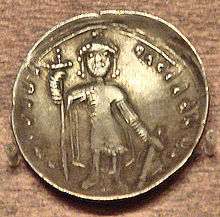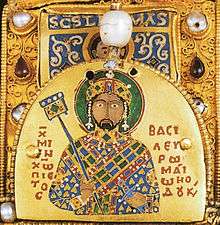Michael VII Doukas
| Michael VII Doukas | |
|---|---|
 Nomisma histamenon of Michael VII Doukas. Emperor with attributes. | |
| Emperor of the Byzantine Empire | |
| Reign | 22 May 1067 –24 March 1078 |
| Predecessor | Romanos IV |
| Successor | Nikephoros III |
| Born | c. 1050 |
| Died | 1090 (aged 40) |
| Spouse | Maria of Alania |
| Issue | Constantine Doukas |
| Dynasty | Doukid dynasty |
| Father | Constantine X |
| Mother | Eudokia Makrembolitissa |
Michael VII Doukas or Dukas/Ducas (Greek: Μιχαήλ Ζ΄ Δούκας, Mikhaēl VII Doukas), nicknamed Parapinakēs (Παραπινάκης, lit. "minus a quarter", with reference to the devaluation of the Byzantine currency under his rule), was Byzantine emperor from 1071 to 1078.
Life
Michael VII was born c. 1050 in Constantinople, the eldest son of Constantine X Doukas and Eudokia Makrembolitissa.[1] He was associated with his father on the throne late in 1059, together with or shortly before his newly born brother Konstantios Doukas.[2] When Constantine X died in 1067, Michael VII was 17 years old and should have been able to rule by himself. He exhibited little interest in politics, however, and his mother Eudokia and uncle John Doukas governed the empire as effective regents.[3]
On January 1, 1068, Eudokia married the general Romanos Diogenes, who now became senior co-emperor alongside Michael VII, Konstantios, and another brother, Andronikos.[4] When Romanos IV was defeated and captured by Alp Arslan of the Seljuk Turks at the Battle of Manzikert in August 1071,[5] Michael VII remained in the background, while the initiative was taken by his uncle John Doukas and his tutor Michael Psellos.[6] They conspired to keep Romanos from regaining power after his release from captivity, while Michael felt no obligation to honor the agreement that Romanos struck with the Sultan.[1] After the dispatch of Eudokia to a monastery, Michael VII was crowned again on October 24, 1071 as senior emperor.
Although still advised by Michael Psellos and John Doukas, Michael VII became increasingly reliant on his finance minister Nikephoritzes.[7] The emperor's chief interests, shaped by Psellos, were in academic pursuits, and he allowed Nikephoritzes to increase both taxation and luxury spending without properly financing the army. As an emperor he was incompetent, surrounded by sycophantic court officials, and blind to the empire collapsing around him.[1] In dire straits, imperial officials resorted to property confiscations and even expropriated some of the wealth of the church. The underpaid army tended to mutiny, and the Byzantines lost Bari, their last possession in Italy, to the Normans of Robert Guiscard in 1071.[6] Simultaneously, they faced a serious revolt in the Balkans, where they faced an attempt for the restoration of the Bulgarian state.[7] Although this revolt was suppressed by the general Nikephoros Bryennios,[7] the Byzantine Empire was unable to recover its losses in Asia Minor.


After Manzikert, the Byzantine government sent a new army to contain the Seljuk Turks under Isaac Komnenos, a brother of the future emperor Alexios I Komnenos, but this army was defeated and its commander captured in 1073.[8] The problem was made worse by the desertion of the Byzantines' western mercenaries, who became the object of the next military expedition in the area, led by the Caesar John Doukas.[8] This campaign also ended in failure, and its commander was likewise captured by the enemy. The victorious mercenaries now forced John Doukas to stand as pretender to the throne. The government of Michael VII was forced to recognize the conquests of the Seljuks in Asia Minor in 1074, and to seek their support.[1] A new army under Alexios Komnenos, reinforced by Seljuk troops sent by Malik Shah I, finally defeated the mercenaries and captured John Doukas in 1074.[9]
These misfortunes caused widespread dissatisfaction, exacerbated by the devaluation of the currency, which gave the emperor his nickname Parapinakēs, "minus a quarter".[1] In 1078 two generals, Nikephoros Bryennios and Nikephoros Botaneiates, simultaneously revolted in the Balkans and Anatolia, respectively.[9] Botaneiates gained the support of the Seljuk Turks, and he reached Constantinople first. Michael VII resigned the throne with hardly a struggle on March 31, 1078 and retired into the Monastery of Stoudios.[10] He later became metropolitan of Ephesus[11] and died in Constantinople in c. 1090.[12]
Before his resignation from the throne, Michael VII may have sent an embassy to Song China, following a series of Byzantine embassies to the earlier Tang Empire of China.[13] From the Wenxian Tongkao, written by Chinese historian Ma Duanlin (1245-1322), and the History of Song it is known that the Byzantine emperor Michael VII Parapinakēs Caesar (Mie li sha ling kai sa 滅力沙靈改撒) of Fu lin (i.e. Byzantium) sent an embassy to China's Song dynasty that arrived in November 1081, during the reign of Emperor Shenzong of Song (r. 1067-1085).[14][13] The History of Song mentions how the Byzantine diplomat and official named "Ni-si-tu-ling-si-meng-p'an" offered saddled horses, sword-blades, and real pearls as tributary gifts to the Song court.[13]
Usurpers
Various usurpers attempted to overthrow Michael VII or rule parts of the empire. These included:
- Nestor – A former slave of Constantine X, Nestor had been promoted to become the dux of Paradounavon,[15] a region bordering the Danube. Having had much of his property and wealth confiscated by the minister Nikephoritzes, he rebelled in around 1076,[15] placing himself at the head of the garrisons under his command, which were already in a state of mutiny due to an arrears in their pay. The troops were eager to plunder the Bulgarians, and Nestor obtained the assistance of one of the chiefs of the Patzinaks before marching onto Constantinople. The rebels demanded the dismissal of Nikephoritzes, but discovering that he didn't have the numbers to attack the capital, Nestor's troops separated into smaller parties and proceeded to plunder Thrace.[16] Defeated by Alexios Komnenos in 1078,[17] Nestor remained with the Patzinaks, and retreated with them back to Paradunavum.[16]
- Philaretos Brachamios
- Caesar John Doukas
- Nikephoros Bryennios
- Nikephoros Botaneiates
Family
Michael VII Doukas married Maria of Alania, daughter of King Bagrat IV of Georgia. By her he had at least one son, Constantine Doukas, co-emperor from c. 1075 to 1078 and from 1081 to 1087/8. He died c. 1095.
See also
Notes
- 1 2 3 4 5 Canduci 2010, p. 273
- ↑ Dumbarton Oaks 1973, p. 779
- ↑ Dumbarton Oaks 1973, p. 780
- ↑ Dumbarton Oaks 1973, p. 785
- ↑ Norwich 1993, p. 353
- 1 2 Norwich 1993, p. 355
- 1 2 3 Norwich 1993, p. 359
- 1 2 Finlay 1854, p. 52
- 1 2 Norwich 1993, p. 360
- ↑ Norwich 1993, p. 361
- ↑ Canduci 2010, p. 274
- ↑ Kazhdan 1991, p. 1366
- 1 2 3 Paul Halsall (2000) [1998]. Jerome S. Arkenberg, ed. "East Asian History Sourcebook: Chinese Accounts of Rome, Byzantium and the Middle East, c. 91 B.C.E. - 1643 C.E.". Fordham.edu. Fordham University. Retrieved 2016-09-10.
- ↑ Fuat Sezgin; Carl Ehrig-Eggert; Amawi Mazen; E. Neubauer (1996). نصوص ودراسات من مصادر صينية حول البلدان الاسلامية. Frankfurt am Main: Institut für Geschichte der Arabisch-Islamischen Wissenschaften (Institute for the History of Arabic-Islamic Science at the Johann Wolfgang Goethe University). p. 25.
- 1 2 Treadgold 1997, p. 607
- 1 2 Finlay 1854, p. 50
- ↑ Treadgold 1997, p. 610
References
- Canduci, Alexander (2010), Triumph & Tragedy: The Rise and Fall of Rome's Immortal Emperors, Pier 9, ISBN 978-1-74196-598-8
- Dumbarton Oaks (1973), Catalogue of the Byzantine Coins in the Dumbarton Oaks Collection and in the Whittemore Collection: Leo III to Nicephorus Iii, 717–1081 see also Dumbarton Oaks, "Michael VII Doukas (1071–1078)", God's Regents on Earth: A Thousand Years of Byzantine Imperial Seals, retrieved May 2016 Check date values in:
|access-date=(help) - Finlay, George (1854), History of the Byzantine and Greek Empires from 1057–1453, 2, William Blackwood & Sons
- Kazhdan, Alexander, ed. (1991), Oxford Dictionary of Byzantium, Oxford University Press, ISBN 978-0-19-504652-6
- Norwich, John Julius (1993), Byzantium: The Apogee, Penguin, ISBN 0-14-011448-3
- Treadgold, Warren (1997), A History of the Byzantine State and Society, Stanford University Press, ISBN 0-8047-2630-2
Attribution:
-
 This article incorporates text from a publication now in the public domain: Chisholm, Hugh, ed. (1911). "Michael: Michael VII". Encyclopædia Britannica. 18 (11th ed.). Cambridge University Press. p. 359.
This article incorporates text from a publication now in the public domain: Chisholm, Hugh, ed. (1911). "Michael: Michael VII". Encyclopædia Britannica. 18 (11th ed.). Cambridge University Press. p. 359.
Further reading
- Garland, Linda (1999), Byzantine Empresses: Women and Power in Byzantium AD 527–1204, Routledge, ISBN 978-0-415-14688-3
- Polemis, Demetrios I. (1968), The Doukai: A Contribution to Byzantine Prosopography, London
Primary sources
- Michael Psellus, Chronographia.
- Michael Attaleiates, The Histories.
- Pseudo-John Skylitzes, Scylitzes Continuatus.
- Anna Komnene, The Alexiad.
External links
| Michael VII Doukas Doukid dynasty Born: c. 1050 Died: c. 1090 | ||
| Regnal titles | ||
|---|---|---|
| Preceded by Constantine X |
Byzantine Emperor 22 May 1067 –24 March 1078 with Konstantios Doukas (1060–1078) Romanos IV (1068–1071), Andronikos Doukas (1068–1078) and Constantine Doukas (1075–1078) as junior co-emperors |
Succeeded by Nikephoros III |